Fairstead, Essex (†Chelmsford) C.13
Passion Cycle
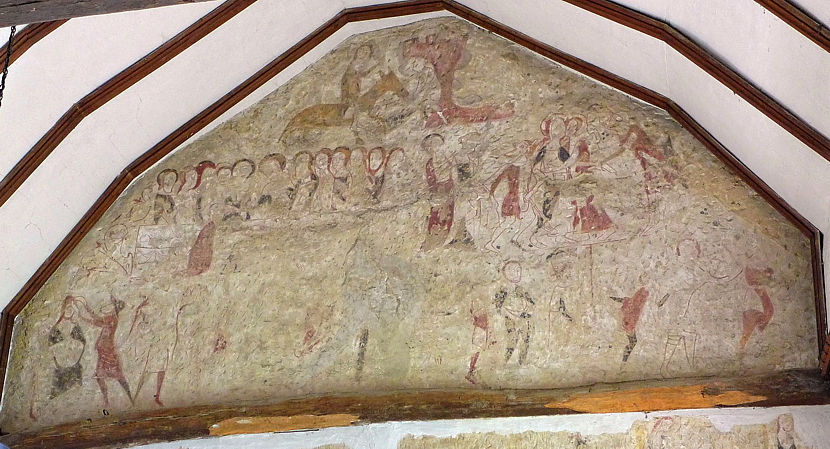
An early Passion Cycle unusually positioned over the chancel arch. Arranged in tiers, it begins at the top with the Entry into Jerusalem (below left). What I took at first for a tree with a figure in it is in fact the gate of Jerusalem, with a battlemented parapet on top (the Passion Cycle at North Cove has a comparable detail). Below the gate a figure is faintly visible, spreading a garment in the Ass’s path.
![Passion Cycle, Fairstead, detail, Entry into Jerusalem [29KB]](images/fairst3.jpg)
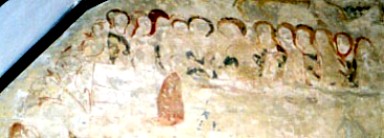
Below this in the second tier is first (from the left) the Last Supper (detail below right), with Christ and eleven disciples behind a long table, while Judas sits opposite on the other side . Christ may be in the act of giving him the sop as described in John 13: 26-27 but precise details are now blurred. A full complement of thirteen figures still visible is rare in English wallpainting.
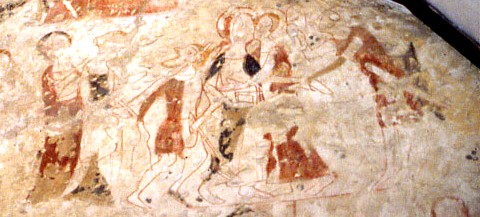
The Betrayal and the Arrest in Gethsemane follow in this tier. At the left-hand side of this scene (detail, below left), a soldier appears to be arresting Christ, who has a halo and a red robe. There are faint traces of a third figure here, and this was I think Peter, whose very long sword extends diagonally to the right to cut off the ear of Malchus, the High Priest’s servant. Malchus has a short, bi-coloured robe and is shown as moving right but looking back left at Christ and the other figures. His face has been rendered grotesque, with an exaggeratedly long, jutting chin. In the centre of the scene, Christ and Judas embrace, while at the right a soldier leans forward to grasp Christ by the arm. There is a good deal of compression and slightly illogical order of scenes here, as is sometimes the case in Passion Cycles.
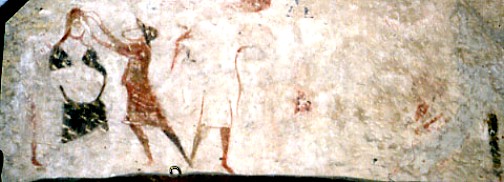
At the right and pictured right here is the lowest tier before the upper horizontal beam. The first scene is the Crowning with Thorns (above right), with Christ now draped in a black or blackened garment which may have been painted in an unstable pigment such as ultramarine or vermilion and thus intended for the ‘gorgeous robe’ of Luke 23:11. The following scene or scenes are reduced to traces only but would probably have been the Scourging and the Mocking.
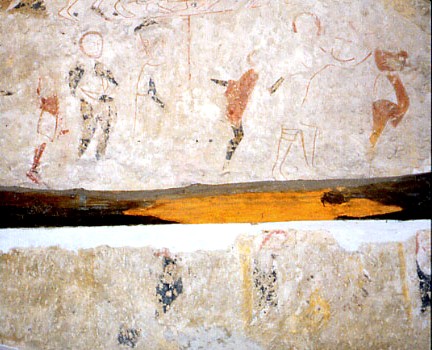
Below at the left are the remaining scenes on the right in this tier, fragmentary, but probably Before Pilate (or Caiaphas) and the Road to Calvary, Christ seems to be in the centre of this scene, but only sketchy details remain.
Finally, below the lower horizontal beam (which would have been the Rood-beam) are two or three further scenes, all faded into obscurity now. The two at the lower right shown here may have been (from left) the Crucifixion and Deposition, but this is little more than guesswork. A single figure is visible at the extreme right and there the painting ends, although it may once have continued around the right angle on to the nave wall.
The painting looks rustic by comparison with the finest 13th century work, although it has a few touches of remarkable elegance, such as the figure of the man crowning Christ with thorns. But it has the dynamism and narrative sweep that make these early examples so attractive. Placing the Passion Cycle on the chancel arch certainly makes for a striking presentation of the story, and that might well be why this position was chosen. The chancel was extended at some date around 1200 and it seems likely that these paintings were made soon afterwards. The very faint paintings on the south wall may date from some time later in the 13th century.
Fairstead is an ancient church in an ancient location and its medieval builders made use of Roman brick, clearly visible in some of the external walls, from some structure even more ancient. This ‘recycling’ of materials from (presumably) derelict Roman buildings is found elsewhere in this part of England.